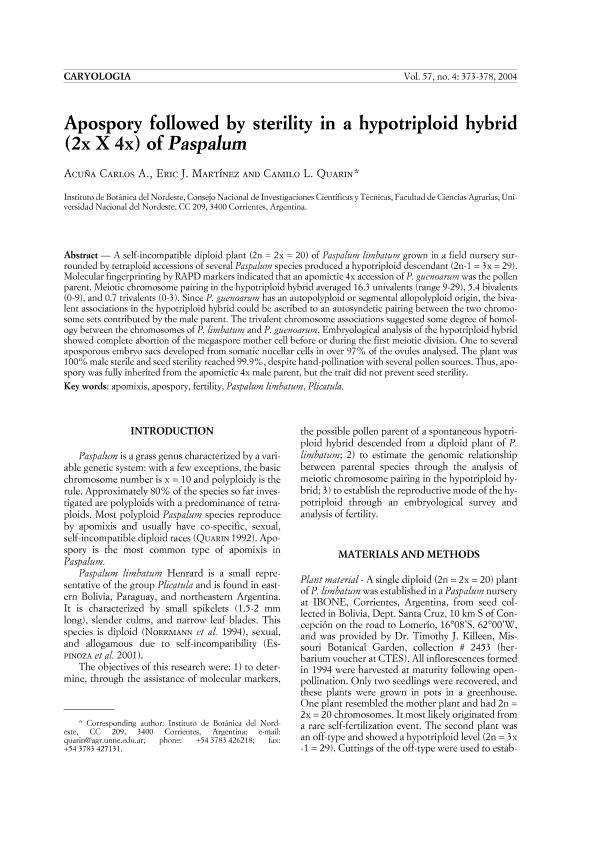Artículo
Apospory followed by sterility in a hypotriploid hybrid (2x X 4x) of Paspalum
Fecha de publicación:
12/2004
Editorial:
Univ Florence Botany Inst
Revista:
Caryologia
ISSN:
0008-7114
e-ISSN:
2165-5391
Idioma:
Inglés
Tipo de recurso:
Artículo publicado
Clasificación temática:
Resumen
A self-incompatible diploid plant (2n = 2x = 20) of Paspalum limbatum grown in a field nursery surrounded by tetraploid accessions of several Paspalum species produced a hypotriploid descendant (2n-1 = 3x = 29). Molecular fingerprinting by RAPD markers indicated that an apomictic 4x accession of P. guenoarum was the pollen parent. Meiotic chromosome pairing in the hypotriploid hybrid averaged 16.3 univalents (range 9-29), 5.4 bivalents (0-9), and 0.7 trivalents (0-3). Since P. guenoarum has an autopolyploid or segmental allopolyploid origin, the bivalent associations in the hypotriploid hybrid could be ascribed to an autosyndetic pairing between the two chromosome sets contributed by the male parent. The trivalent chromosome associations suggested some degree of homology between the chromosomes of P. limbatum and P. guenoarum. Embryological analysis of the hypotriploid hybrid showed complete abortion of the megaspore mother cell before or during the first meiotic division. One to several aposporous embryo sacs developed from somatic nucellar cells in over 97% of the ovules analysed. The plant was 100% male sterile and seed sterility reached 99.9%, despite hand-pollination with several pollen sources. Thus, apospory was fully inherited from the apomictic 4x male parent, but the trait did not prevent seed sterility.
Palabras clave:
Apomixis
,
Apospory
,
Fertility
,
Paspalum Limbatum
,
Plicatula
Archivos asociados
Licencia
Identificadores
Colecciones
Articulos(IBONE)
Articulos de INST.DE BOTANICA DEL NORDESTE (I)
Articulos de INST.DE BOTANICA DEL NORDESTE (I)
Citación
Acuña, Carlos Alberto; Martínez, Eric Javier; Quarin, Camilo Luis; Apospory followed by sterility in a hypotriploid hybrid (2x X 4x) of Paspalum; Univ Florence Botany Inst; Caryologia; 27; 4; 12-2004; 373-378
Compartir
Altmétricas




